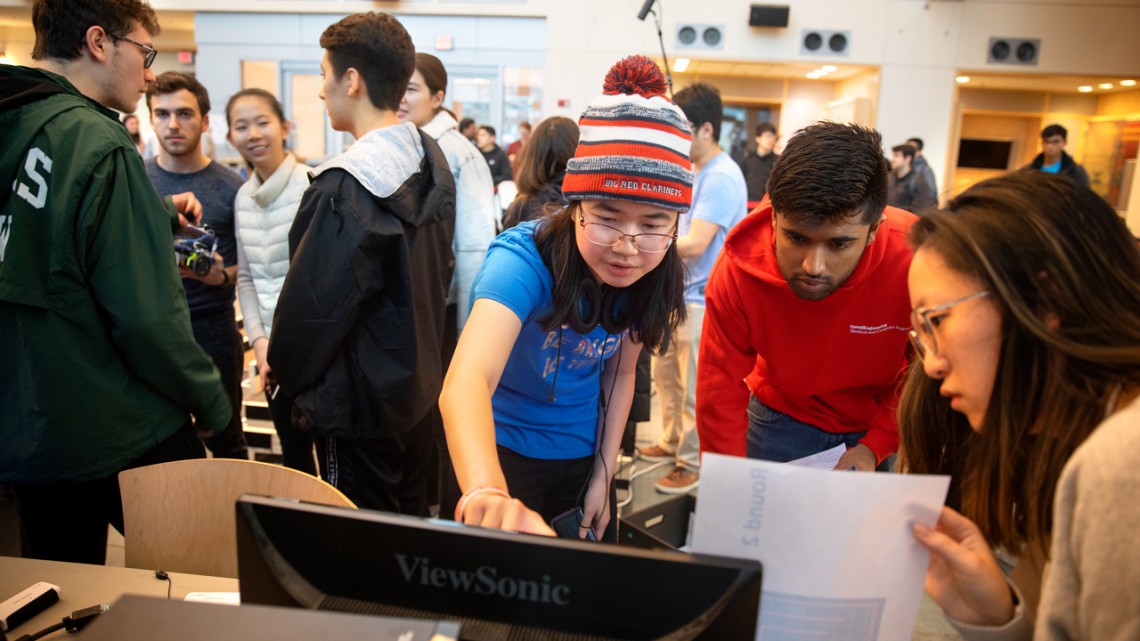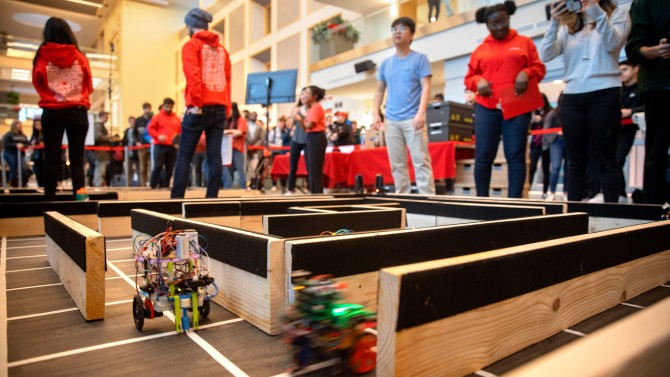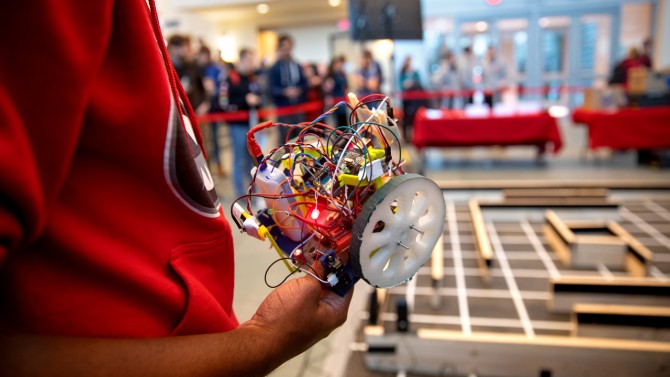
Cornell Engineering students participate in the “Robotic Maze Runners” competition Dec. 10 in Duffield Hall atrium.
Students go all in at robotics competition
By David Nutt
More than 100 engineering students let off some end-of-semester steam and tried not to blow any gaskets at the annual Robotics Day competition Dec. 10 in Duffield Hall atrium.
The day kicked off with the “Robotic Maze Runners” morning competition. Each round featured four robots equipped with sensors and navigation algorithms that were placed in a 9-by-9-foot maze. Over the course of six minutes, the robots attempted to map the maze by following a grid of white lines while avoiding walls and other robots. The information each robot recorded was then transmitted wirelessly to a base station, which decoded the transmission and visualized the map.
The maze game helps students integrate their previous knowledge of analog and digital signal processing with a new understanding of circuitry, while building their problem-solving and teamwork skills, said lecturer and senior research associate Carl Poitras, who oversaw the maze competition as part of his Intelligent Physical Systems course.
“The students work hard,” said Poitras. “It’s nice to see how really involved and carried away – in a good way – they get with the competition. That aspect I always love. Even if there’s disappointment for those who don’t make it to subsequent rounds, I reassure them that the grade is not only about the competition but everything else.”
Poitras added a few more challenges to this year’s maze competition. Students had to outfit their robots with LEDs that emitted infrared light, so the robots could detect each other. And each round was initiated by a brief melody that played over speakers placed in the mazes. The robots were tasked with identifying a specific note with a frequency of 950 hertz that was their cue to begin.
“The competition was tough, but the students learned so much,” Poitras said. “They got so much out of it.”
The winning team, Secondhand Salt, consisted of Daniel Buscaglia ’21, Jinny Gui ’21, Ryan McMahon ’21 and Joy Thean ’21. Their victory had extra dramatic flair, given that their robot, Axel, almost didn’t make it to the competition.
“Our robot wasn’t really working at 9 p.m. yesterday,” Gui said afterward. “We were in open lab hours until 3:30 [a.m.]. We just grinded. It was mostly working before that, and then things broke along the way. We somehow managed to fix everything.”
In addition to the thrill of competition, Gui said she really enjoyed watching the robots collide. Indeed, there were a few “BattleBots”-type moments that drew wild cheers and the occasional gasp from the audience.
“I like seeing how into it the students get. They’ll start cheering or booing a robot they don’t like, or clapping, yelling ‘Oh’ when something unexpected happens,” said Ben Finio, lecturer in the Sibley School of Mechanical and Aerospace Engineering. “Compared to getting into finals and the stress of exams and everything, this is a pretty good outlet, and it’s nice to see them actually smile and get enthusiastic about something.”
For the afternoon’s “Cube Crazy Robots” competition, students in Finio’s Mechatronics course designed robots that faced off, one-on-one, on a 16-square-foot, blue and yellow field. Competing robots tried to pull or push 1-inch-square wooden blocks from their opponent’s side back to their own.
“Building a basic robot that can drive around isn’t really that hard. Everybody can kind of get to that level,” Finio said. “I think the challenge is coming up with the strategy to make it navigate around this board and not get lost.”
First place went to Birthday Bot and team members Andreea Foarce ’21, Chendan Luo ’22 and MacKenzie Harnett ’21. In the final competition of the day, Birthday Bot emerged victorious against a robot built by ASML, the Dutch chip-machine manufacturer that has sponsored the event for seven years. It marked the first time that the Cornell champion defeated the ASML robot.
Ken Bogursky ’96, senior manager of mechanical development at ASML, said the competition encourages its engineers to collaborate in new ways while also giving the company an opportunity to engage more deeply with students. Since the competition began, Bogursky estimates ASML has hired more than 40 Cornell engineers for its Connecticut division alone, more than from any other university.
“They’re all fantastic,” Bogursky said. “There’s something really unique about Cornell’s engineering program. You’ve got the best and the brightest here, the most energetic and enthusiastic, students that really know how to work together as a team. It’s just so great to see it while they’re at the university and then later in their careers.”
Media Contact
Get Cornell news delivered right to your inbox.
Subscribe


